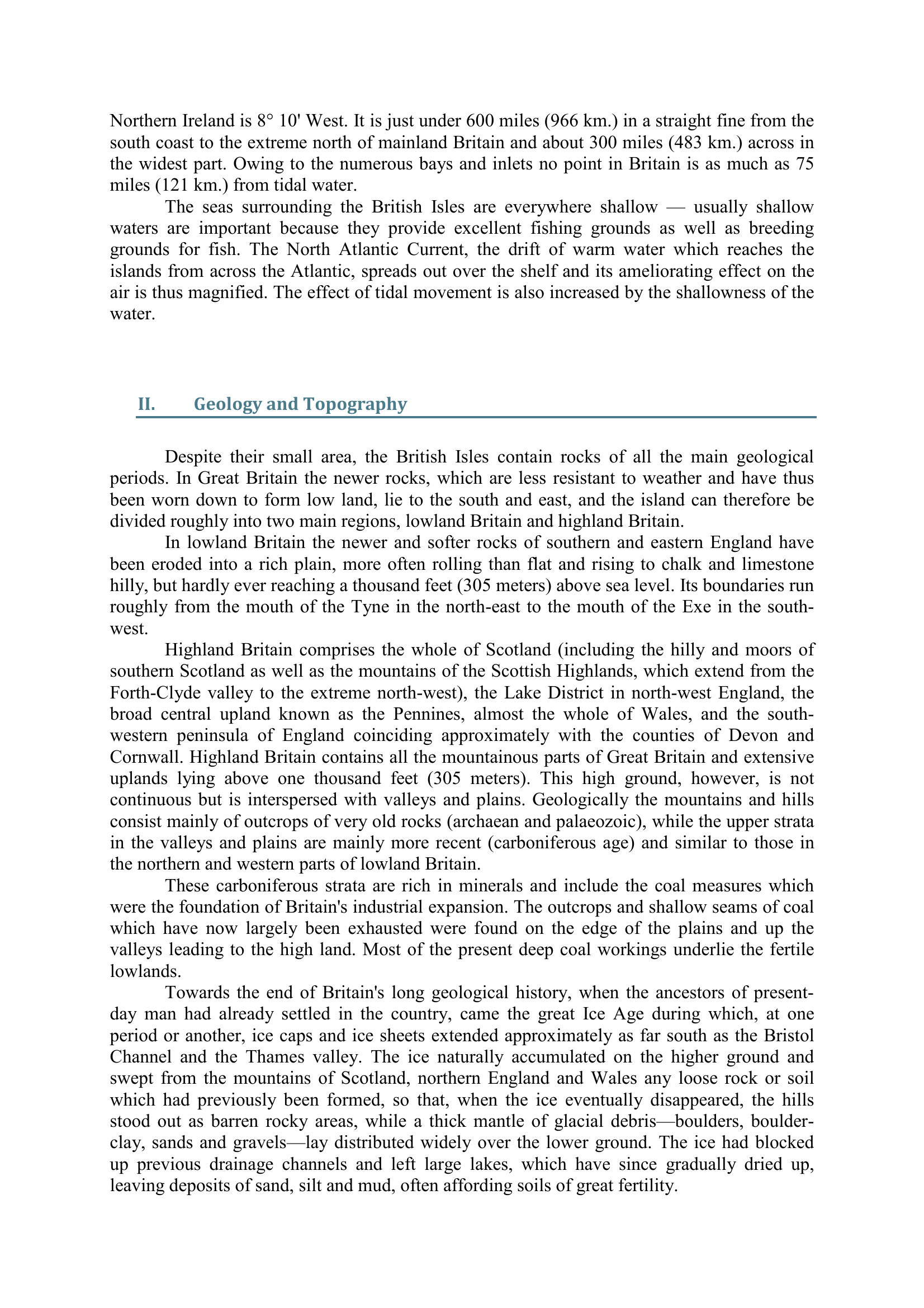Britain: The physical background
Publié le 29/02/2012

Extrait du document
Plan
I. The Land ............................................................................................................................................ 1
II. Geology and Topography ............................................................................................................. 2
III. Climate ................................................................................................................................................ 3
IV. Soil and Vegetation ........................................................................................................................ 4
V. Fauna ................................................................................................................................................... 5
I. The Land
Britain, formally known as the United Kingdom of Great Britain and Northern Ireland, constitutes the greater part of the British Isles, a group of islands lying off the north-west coast of Europe. The largest islands are Great Britain (comprising the main lands of England, Wales and Scotland) and Ireland (comprising Northern Ireland and the Irish Republic). Off the southern coast of England is the Isle of Wight and off the extreme south-west are the Isles of Scilly; off north Wales is Anglesey. Western Scotland is fringed by numerous islands and to the far north are the important groups of the Orkneys and Shetlands. All these have administrative ties with the mainland, but the Isle of Man in the Irish Sea and the Channel Islands between Great Britain and France have a large measure of administrative autonomy and are not part of England, Wales, Scotland or Northern Ireland.
«
Northern Ireland is 8° 10' West.
It is just under 600 miles (966 km.) in a straight fine from the
south coast to the extreme north of mainland Britai n and about 300 miles (483 km.) across in
the widest part.
Owing to the numerous bays and inl ets no point in Britain is as much as 75
miles (121 km.) from tidal water.
The seas surrounding the British Isles are everywhe re shallow usually shallow
waters are important because they provide excellent fishing grounds as well as breeding
grounds for fish.
The North Atlantic Current, the d rift of warm water which reaches the
islands from across the Atlantic, spreads out over the shelf and its ameliorating effect on the
air is thus magnified.
The effect of tidal movement is also increased by the shallowness of the
water.
II. Geology and Topography
Despite their small area, the British Isles contain rocks of all the main geological
periods.
In Great Britain the newer rocks, which ar e less resistant to weather and have thus
been worn down to form low land, lie to the south a nd east, and the island can therefore be
divided roughly into two main regions, lowland Brit ain and highland Britain.
In lowland Britain the newer and softer rocks of so uthern and eastern England have
been eroded into a rich plain, more often rolling t han flat and rising to chalk and limestone
hilly, but hardly ever reaching a thousand feet (30 5 meters) above sea level.
Its boundaries run
roughly from the mouth of the Tyne in the north-eas t to the mouth of the Exe in the south-
west.
Highland Britain comprises the whole of Scotland (i ncluding the hilly and moors of
southern Scotland as well as the mountains of the S cottish Highlands, which extend from the
Forth-Clyde valley to the extreme north-west), the Lake District in north-west England, the
broad central upland known as the Pennines, almost the whole of Wales, and the south-
western peninsula of England coinciding approximate ly with the counties of Devon and
Cornwall.
Highland Britain contains all the mountai nous parts of Great Britain and extensive
uplands lying above one thousand feet (305 meters).
This high ground, however, is not
continuous but is interspersed with valleys and pla ins.
Geologically the mountains and hills
consist mainly of outcrops of very old rocks (archa ean and palaeozoic), while the upper strata
in the valleys and plains are mainly more recent (c arboniferous age) and similar to those in
the northern and western parts of lowland Britain.
These carboniferous strata are rich in minerals and include the coal measures which
were the foundation of Britain's industrial expansi on.
The outcrops and shallow seams of coal
which have now largely been exhausted were found on the edge of the plains and up the
valleys leading to the high land.
Most of the prese nt deep coal workings underlie the fertile
lowlands.
Towards the end of Britain's long geological histor y, when the ancestors of present-
day man had already settled in the country, came th e great Ice Age during which, at one
period or another, ice caps and ice sheets extended approximately as far south as the Bristol
Channel and the Thames valley.
The ice naturally ac cumulated on the higher ground and
swept from the mountains of Scotland, northern Engl and and Wales any loose rock or soil
which had previously been formed, so that, when the ice eventually disappeared, the hills
stood out as barren rocky areas, while a thick mant le of glacial debrisboulders, boulder-
clay, sands and gravelslay distributed widely over the lower ground.
The ice had blocked
up previous drainage channels and left large lakes, which have since gradually dried up,
leaving deposits of sand, silt and mud, often affor ding soils of great fertility..
»
↓↓↓ APERÇU DU DOCUMENT ↓↓↓
Liens utiles
- Ne pas confondre Grande Bretagne et Royaume Uni Great Britain Great Britain is made up of: England - The capital is London.
- Le Royaume Uni, les USA La Grande Bretagne Britain Les îles britanniques The British
- Education in Great Britain ? Education is compulsory from the age of 5 (4 in Northern Ireland) to the age of 16.
- Pop Art Pop Art, visual arts movement of the 1950s and 1960s, principally in the United States and Britain.
- Thermodynamics I INTRODUCTION Thermodynamics, field of physics that describes and correlates the physical properties of macroscopic systems of matter and energy.


